
Download the PDF of this article
Nursery and Reception children at Co-op Academy Oakwood, Leeds have turned their Foundation Unit into a building site as they immerse themselves in construction. ‘We call them our cohort of builders because it’s incredible what they make and construct,’ says early years team leader and assistant head Maeve Birdsall.
This year, practitioners have been surprised by the level of children’s interest in building then collaborating on increasingly bigger projects. One day, shelves in the Reception construction area were bare by 9.30am, and the children have since gone on to use all the building materials from other classrooms too as they have developed whole cities. Their interest has also inspired the nursery children to embark on their own building projects (see box).
Inspired by the Reggio Emilia approach, the Foundation Unit aims to promote children’s and practitioners’ creativity within a rich and responsive environment. ‘We feel there are enormous benefits from being based in a unit,’ says Ms Birdsall. ‘The older children tend to be more sustained in their interests, but as the school year goes on, we see that the nursery children are also more and more sustained. We feel that the older children show the younger children what they can achieve.
‘How we respond to children’s interests is critical to extending their learning. We want to give them the opportunities and the chance to explore, make links and create. We never know from one day to the next what they’ll create.’
A new block area and more open space to build may be factors in the children’s increased fascination with construction. Along with large wooden blocks, practitioners provide a wide range of open-ended resources for the children to use, including lots of recycled materials and loose parts which are donated or sourced from a local scrap store.
Practitioners find that these ‘intelligent materials’ encourage children to use their imagination and creativity because they can provide endless possibilities as children explore their own lines of enquiry. The practitioners allow the children to take the lead in their learning and support them by providing new resources and provocations or introducing new ideas to extend the children’s explorations.
‘One thing leads to another and we add more things for the children to include,’ says Ms Birdsall.
Fantasy cities

Initially, the Reception children used the wooden blocks to build structures, then began to add details, such as buttons, bottle tops and shiny jewels. Children made fantasy cities and named them after particular features, such as Spin City. One child explains, ‘In Spin City everything spins. The animals live in Spin City. There is a flower building in Spin City.’
The buildings have inspired the children to create and tell their own stories. In March, activities based on World Water Day prompted some children to create Fish City on lengths of blue fabric.
Reception teacher Jasmine Priestley says, ‘We saw a lot of children make individual pieces, but then they started to join them together, because they looked at maps and talked about roads and rivers and noticed how cities connected. The children started to collaborate and work together.’
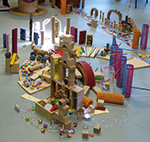 Practitioners have observed how children have gradually developed precision in their construction techniques and used increasingly adventurous materials as they share and develop their ideas. Children used lights in Rainbow City, along with disco balls and party people. One boy used a torch to see if light would pass through his construction, then drew a detailed diagram showing the paths of light.
Practitioners have observed how children have gradually developed precision in their construction techniques and used increasingly adventurous materials as they share and develop their ideas. Children used lights in Rainbow City, along with disco balls and party people. One boy used a torch to see if light would pass through his construction, then drew a detailed diagram showing the paths of light.
The children have also been motivated to add labels to their creations to explain them to others.
In the woodwork area, the children built a city out of wood and painted on windows, but the city theme has not been limited to construction. Children have also drawn large-scale plans of their cities on big sheets of paper. One girl carefully drew Swirl City – a place where kings and queens live. As with the buildings, children began to collaborate and link their city drawings together with paper roads, train tracks and bridges spread all over the floor.
The ‘Big Build’
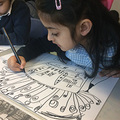
The children’s interest in building cities has lasted about two months and gradually become more factual. ‘A little girl visited family in Peru and came back talking about the capital city Lima, while a couple of other children had recently visited London, so they discussed that,’ explains Ms Priestley. ‘There has been lots of talk about where they have been and cultural references. We decided to explore more about cities, so we printed out lots of images of cities such as London and New York and showed them maps and footage of cities online.’
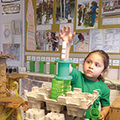 The Reception children enjoy having meetings, enabling practitioners to learn about the children’s thoughts and how they want to develop their ideas. ‘The children feel listened to and in charge of their own learning. It is a two-way process rather than just us taking the lead,’ says Ms Priestley. ‘Through the meetings, the children also learn to be respectful to each other, listen to others, gain confidence to speak in a group and to share their ideas.’
The Reception children enjoy having meetings, enabling practitioners to learn about the children’s thoughts and how they want to develop their ideas. ‘The children feel listened to and in charge of their own learning. It is a two-way process rather than just us taking the lead,’ says Ms Priestley. ‘Through the meetings, the children also learn to be respectful to each other, listen to others, gain confidence to speak in a group and to share their ideas.’
Investigating real cities led to a ‘Big Build’, lasting a full day. The practitioners moved all the furniture to the edges of the classroom to create space for the 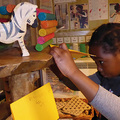 children to embark on building and decorating their own city with resources gathered from throughout the Unit, such as boxes, crates, blocks and recycled materials. Included in their city, covering the whole of the classroom floor, were lots of houses, a car park, Big Ben, a mosque, train tracks, roads and lots of tall towers.
children to embark on building and decorating their own city with resources gathered from throughout the Unit, such as boxes, crates, blocks and recycled materials. Included in their city, covering the whole of the classroom floor, were lots of houses, a car park, Big Ben, a mosque, train tracks, roads and lots of tall towers.
‘It was a mix of cities but included lots of features of London and also cultural influences,’ says Ms Priestley. ‘The children were really focused and continued to go back to the build. They used their phonics skills to add labels, such as signs for the mosque and car park. It was nice to see that they saw writing as a way to show and to explain and that they were excited to show people what they had made.’
Past and present
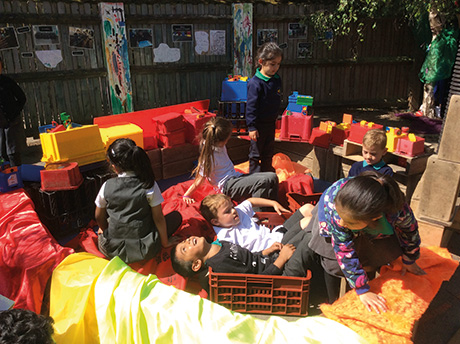
Currently fascinated by a history book of London, the children are enjoying comparing the city past and present and learning about the Great Fire of London. ‘We’ve noted children always find natural elements fascinating probably because there is beauty and danger in them,’ says Ms Priestley.
Children started to add fire to their city artwork and add impressions of fire to their constructions. ‘We provided more resources for the children to use, mainly fabrics and sheets of bright Perspex colours,’ Ms Priestley says. ‘We noticed that children were fascinated by vibrant colours so we searched for those and put them in the construction area.’
Practitioners supported the children’s interest by covering a wall with white paper and projecting a big image of the Great Fire of London onto it. The children were encouraged to look at it and add their own marks to the projection. They went on to make a big model outside using colour fabric to represent the fire. The Reception children are now preparing to have a real fire in their new fire pit.
Working together
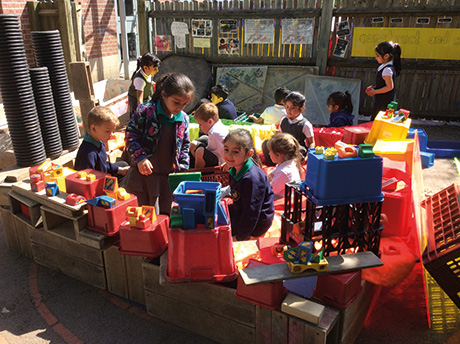
‘The children’s construction explorations have been really fun and have outcomes in every area,’ says Ms Priestley. ‘There has been lots of expressive arts and imaginative use of a wide range of media. Along with the skills involved in construction, there has been a lot of communication with children working together to problem-solve. It has opened up conversations such as discussing different places, cultures and celebrations. Children asked questions about the mosque and the girl who built it told them about being a Muslim. Another boy added that he’s a Christian and goes to church, while the child whose mum is from Peru was able to bring in pictures and it opened up conversations about different families and languages. It’s been wonderful observing what they are building and listening to them talk.’
Nursery children
The excitement about construction, especially the ‘Big Build’, has spread to the nursery children and many have been independently building their own cities. Practitioners are planning on taking the nursery children into Leeds so that they can explore and look at what their own city looks like.
Maeve Birdsall observes that there is regularly a leader who directs the play. A four-year-old girl is often at the heart of the creations and displays leadership skills as she gets children on board with what she is building. She has been immersed in designing and building a wide range of structures linked to her experiences. She recently went to the cinema so she built her own cinema and then the following week created Hotel Transylvania, inspired by an animation she had watched.
‘She was really proud of her Hotel Transylvania. She said that it was like a city and linked it to the theme that she’d seen the older children do,’ says Ms Birdsall. ‘A boy joined in with her building. He is interested in light and said that we needed to see it more clearly so he brought a light over and carefully positioned it.’
The children are also inspired by what they find in the nursery environment. Another child decided to build a tall tower with scrap store materials and carefully balance them together. ‘When he’d finished he saw an ant crawl to his tower so he announced that it was actually an ant house and became fascinated by the ant, so we gave him a magnifying glass to examine it more closely,’ recalls Ms Birdsall. Others built a ‘slug display’ after overturning a log and finding lots of slugs.
Building skills
Practitioners take photographs of the children’s constructions and make them into books for them to look at. Children will often gain inspiration from the books and then gather materials to make their own versions.
‘It’s inspiring watching the children,’ says Ms Birdsall. ‘They display great collaboration skills as they talk to each other and negotiate what will go where. I really like it that the children are happy for others to add bits to their constructions and then go away. This is something that has developed over the year. We encourage them to ask if it’s OK to help, and most of the time it is.’
She points out how all the Characteristics of Effective Learning can be developed through construction, from seeking challenge and exploring to maintaining focus and perseverance – ‘Our cinema-builder wrote a “Do not touch” sign for it. I suggested that she stick it to her structure but she pressed too hard and lots of the building fell down and she had to start again.’
As with Reception’s ‘Big Build’, the nursery children are encouraged to use their imaginations. One child enjoys decorating her constructions and wants to decorate the whole school. ‘We can do whatever we want, decorations inside and outside,’ she says. ‘We need a hundred things! A million things! Then I can write a sign!’
BOOK CORNER
 Block City
Block City
by Robert Louis Stevenson and Daniel Kirk
Encourage children to build their own dreams with this classic poem combined with bright block illustrations.
 Iggy Peck, Architect
Iggy Peck, Architect
by Andrea Beaty and David Roberts
Building is Iggy’s passion. While his parents are proud of his fabulous creations, his teacher declares a dislike of architecture, but Iggy loves building too much to give it up.
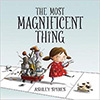 The Most Magnificent Thing
The Most Magnificent Thing
by Ashley Spires
Wanting to make a magnificent thing isn’t easy. A child’s frustration and anger is vividly depicted as she repeatedly tries and fails before dealing with her emotions and being reassured that it’s alright to make mistakes and persevere.
What Do You Do with an Idea?
by Kobi Yamada and Mae Besom
This is a story for anyone who’s ever had an idea that seemed too big, too odd or too difficult. It’s a story to inspire you into welcoming that idea, giving it space to grow and then seeing what happens.
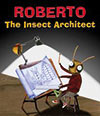 Roberto: The Insect Architect
Roberto: The Insect Architect
by Nina Laden
A funny and inspirational tale of Roberto, a termite who isn’t living up to his job description. Instead of eating houses, he is building them.
 Cool Architecture
Cool Architecture
by Simon Armstrong
Explore simple dwellings created by the earliest humans to today’s most innovative buildings, via forbidding medieval strongholds and New York’s Art Deco skyscrapers.
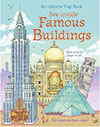 See Inside Famous Buildings
See Inside Famous Buildings
by Rob Lloyd Jones and Barry Ablett
Discover some of the world’s most famous buildings with this Usborne flap book. Illustrations of buildings including the Himeji Castle, Versailles Palace and Blue Mosque open to reveal their interiors.
 London For Children
London For Children
by Matteo Pericoli
Tour the South and North Bank of the River Thames and investigate the city’s historic and modern buildings in this beautifully illustrated book.









